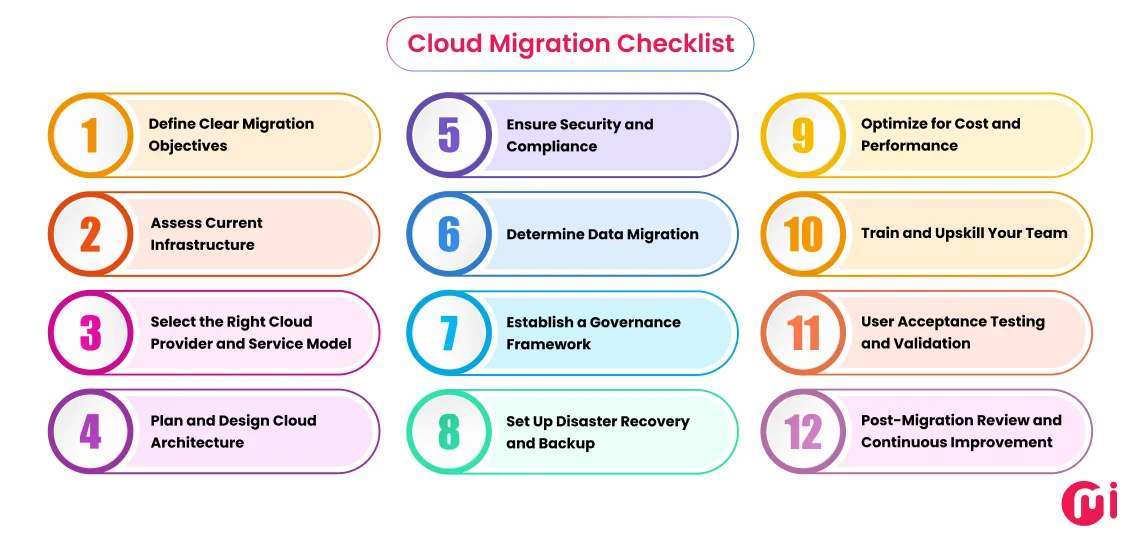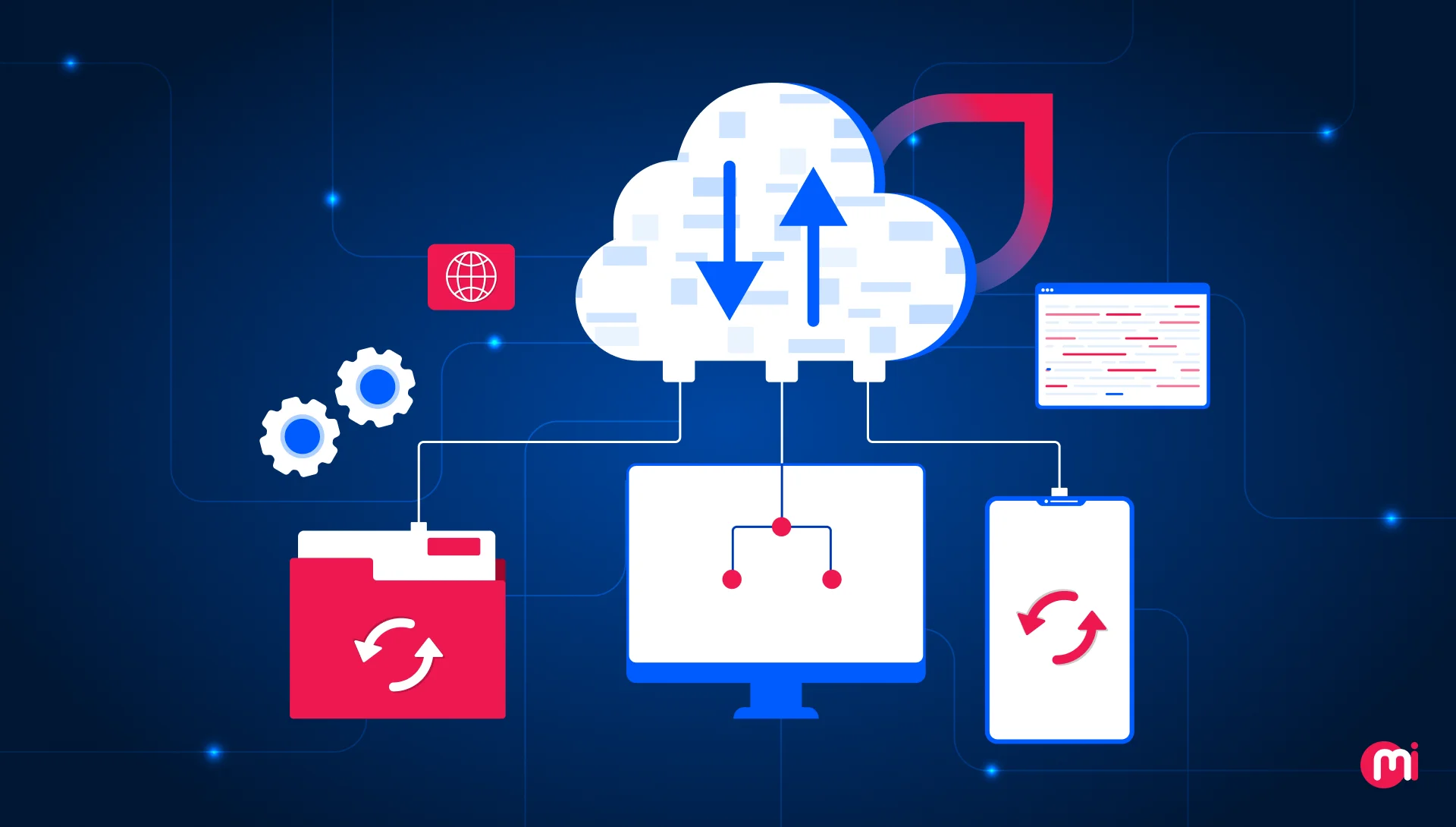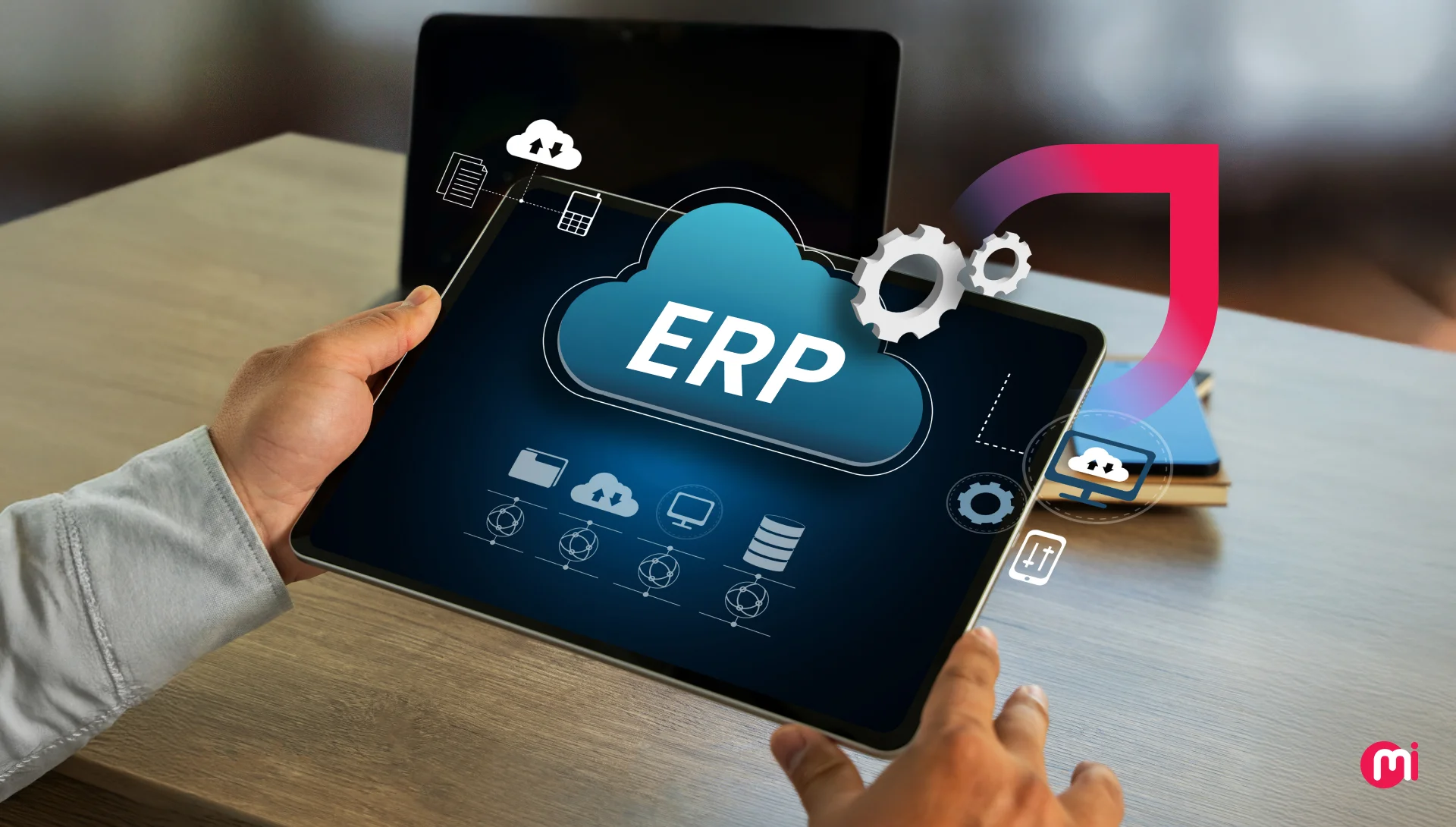Step-By-Step Cloud Migration Checklist For Effective Planning
- Cloud
- June 3, 2025
Cloud migration is a strategic shift that requires more than just technical execution—it needs a clear, structured approach. This blog outlines a complete cloud migration checklist covering critical areas like goal setting, infrastructure assessment, provider selection, security, data migration, disaster recovery, and ongoing optimization. It’s designed to help you streamline the transition, reduce risks, and build a scalable foundation for long-term cloud success.
According to recent cloud computing statistics, over 94% of organizations with more than 1,000 employees now run a significant share of their workloads in the cloud. Moreover, the majority of enterprises have either adopted or are actively planning to adopt cloud solutions to enhance operational performance and maintain competitive advantage.
But here’s the catch: cloud migration isn’t just about moving stuff to the cloud; it’s a strategic shift that touches every part of your tech stack, from infrastructure and security to user experience and long-term scalability. One wrong move can mean data loss, downtime, or a blown budget. That’s why having a solid cloud migration checklist is essential and helpful.
But what does it include?
What are the main aspects of the cloud migration checklist?
This blog breaks down everything about the cloud migration checklist you need to consider before, during, and after the move. Whether you’re lifting and shifting an app, rearchitecting a monolith, or migrating an entire ecosystem, this checklist will make your transition smooth, secure, and more impactful.

How Does a Cloud Migration Checklist Ensure a Smooth Transition?
Cloud migration is a strategic mode but it’s also a complex one and there are many phases of cloud migration. Without a clear structure, you cannot leverage the benefits of cloud computing, and also it’s easy to overlook critical steps, leading to unexpected delays, security risks, or budget overruns.
In this scenario, a comprehensive cloud migration checklist can serve as a practical roadmap, guiding your team through every phase of the migration journey.
From assessment and planning to data transfer, testing, and post-migration optimization, it ensures that nothing falls through the cracks. It brings clarity to the process, aligns team members, and helps maintain focus on both technical and business goals.
More importantly, it reduces risk by identifying dependencies and challenges early, allowing you to act proactively rather than reactively. With a precise cloud migration checklist in place, your cloud migration becomes less about guesswork and more about smooth execution, long-term efficiency, and measurable results.
Read to know more: The In-Depth Guide About Cloud Business Intelligence
12 Step Cloud Migration Checklist
Effective cloud migration starts with smart planning and ends with continuous optimization. To help you plan well and migrate to the cloud seamlessly, here is the comprehensive checklist to migrating to the cloud:

1. Define Clear Migration Objectives
Ponder over your migration objectives and know why you are migrating to the cloud.
- Is it to cut costs or to improve scalability, enhance performance, or enhance security?
After identifying them, turn these objectives into measurable goals. For example, if you want to reduce infrastructure costs by 30% over the next year or achieve 99.9% uptime for customer-facing applications.
Map each objective to specific workloads or systems to prioritize what moves first. Clear, business-aligned goals keep your migration focused and help you evaluate success after the transition. Think of this step as setting the foundation for the entire project.
2. Assess Current Infrastructure
Before leaping to the cloud, you need to follow the cloud migration assessment checklist to get a clear picture of what you’re working with. Audit your current IT environment, including servers, applications, databases, storage, and network dependencies. Identify components that are cloud-ready, need refactoring, or might be better left on-premise (at least for now).
Pay close attention to performance bottlenecks, licensing constraints, and interdependencies between systems. Tools like application discovery and dependency mapping can help automate this process.
The goal is to create a full inventory, understand how everything fits together, and create a cloud migration strategy that’s smooth, secure, and based on real data, not guesswork.
3. Select the Right Cloud Platform and Services Provider
Major cloud platforms like Amazon Web Services (AWS), Microsoft Azure, Google Cloud Platform (GCP), IBM Cloud, and Oracle Cloud offer a wide range of capabilities, pricing models, and tools. Choose a platform that aligns with your technical needs, business goals, and long-term strategy.
Now look for reliable cloud engineering services and solutions providers that have required compliance certifications. Don’t pick providers based on popularity; choose the provider that best aligns with your technical needs and business goals.
Also, choose the service model from IaaS, PaaS or SaaS if you are moving to fully managed applications. Consider your team’s expertise, integration requirements, and long-term scalability. The right combination here will directly impact performance, cost, and how easily you can manage your cloud environment.

4. Plan and Design Cloud Architecture
Now that you’ve chosen your cloud provider, it’s time to map out how your systems will live and work in the cloud. Design a cloud architecture that aligns with your business needs, performance goals, and compliance requirements.
Define how applications, data networks, and security components will interact. Decide on key aspects like multi-zone deployment for high availability, auto-scaling for flexibility, and storage types for different data needs.
There are several types of cloud computing, each designed to meet different business needs and technical requirements. These include public, private, hybrid or multi cloud and you have to choose the ideal one fulfilling your technical requirements.
Also, plan for integration with existing on-premise systems if you have plans to opt for a hybrid cloud. Use best practices for cloud architecture design to ensure a secure, resilient, and cost-effective setup. This roadmap will guide your migration and shape how your cloud environment performs post-launch.
Also Read: Serverless Architecture for Cloud-based App Development: Top Benefits and Challenges
5. Ensure Security and Compliance
Cloud security isn’t something to deal with after migration—it needs to be baked into your plan from the start. Identify your organization’s specific security requirements and regulatory obligations. Work with your cloud provider to understand their shared responsibility model, what they secure versus what you’re responsible for.
Set up identity and access management (IAM), and encryption for data at rest and in transit, firewalls, and monitoring tools. Don’t forget compliance audits, logging, and backup policies. Building a secure and compliant cloud environment early helps avoid risks, protects sensitive data, and keeps you in line with industry regulations from day one.
6. Determine Data Migration
Once your cloud architecture is defined, follow the cloud database migration checklist and plan how your data will make the move. Acknowledge which data sets need migration, and define their size, sensitivity, and significance in the business.
Choose a cloud migration strategy from end-to-end migration or in-stage migration after weighing complexity and downtime tolerance.
You’ll also need to select the right tools or services for the job, such as offline transfer, real-time replication, or database migration tools offered by your cloud provider. Don’t forget to validate data integrity, set up failover mechanisms, and plan for minimal disruption. A well-thought-out data migration plan ensures accuracy, security, and business continuity throughout the move.
7. Establish a Governance Framework
Define clear policies for resource provisioning, access control, cloud cost optimization, and compliance monitoring. Assign roles and responsibilities to ensure accountability, and implement guardrails like tagging standards, budget alerts, and usage limits. Use tools offered by your cloud provider for policy enforcement, audit trails, and reporting.
Good governance ensures that your cloud usage stays secure, compliant, and cost-efficient while giving teams the flexibility they need to innovate responsibly. It’s not about control but smart management at scale.
8. Set Up Disaster Recovery and Backup
Once your workloads are in the cloud, protecting them against unexpected failures is critical. Identify your objectives, including Recovery Time Objective (RTO) and Recovery Point Objective (RPO) for each system following application migration to cloud checklist. These metrics will guide the backup frequency and restoration strategy.
Choose cloud-native tools that automate snapshots, replicate data across regions, and provide versioning to avoid data loss. Make sure your disaster recovery plan covers critical systems, data, and configurations.
Also, test your backup and restore process regularly to ensure it works under real-world failure conditions. A reliable backup and DR setup ensures business continuity even in the face of major outages or accidental data loss.
9. Optimize for Cost and Performance
After migrating to the cloud, it’s essential to fine-tune your environment to balance operational efficiency with cost-effectiveness. To start with, analyze resource utilization and identify underused instances, idle services, or over-provisioned storage based on real usage patterns instead of projected needs.
Use built-in tools from your cloud provider to identify cost-saving opportunities. Implement auto-scaling, schedule non-critical workloads to run during off-peak hours, and leverage reserved or spot instances for further savings.
Also, monitor performance using real-time analytics to ensure your applications are meeting SLAs without unnecessary overhead. Regular optimization helps you get the most value from your cloud investment while keeping systems agile and responsive.
10. Train and Upskill Your Team
Once your infrastructure starts shifting to the cloud, your team must have the skills to manage, secure, and optimize it. Assess current skill gaps related to cloud platforms, DevOps, security, and compliance.
Invest in formal training programs or certifications offered by cloud providers. Encourage hands-on practice through sandbox environments, workshops, and real project exposure. It’s also helpful to foster a learning culture by promoting internal knowledge sharing and staying updated with evolving cloud trends.
A well-trained team is required for maintaining your cloud environment, avoiding costly errors, and continuously improving cloud operations.
11. User Acceptance Testing and Validation
User Acceptance Testing (UAT) is the final checkpoint where real users validate the system in a controlled environment. In this step, you must follow a cloud migration testing checklist and confirm that the cloud-deployed application meets business requirements, performs reliably, and provides a seamless user experience.
Define clear UAT criteria and scenarios based on real-world usage. Involve key stakeholders, such as product owners, power users, or client representatives to conduct thorough testing. Monitor for bugs, performance issues, or feature gaps, and resolve them promptly. UAT not only prevents post-deployment surprises but also builds user confidence before full-scale rollout.
12. Post-Migration Review and Continuous Improvement
A thorough post-migration review helps assess what went well, what didn’t, and where improvements are needed. Hence, evaluate performance, security, user feedback, and cost metrics against your original goals. This step ensures the migration delivers the expected value.
Document key learnings, update operational processes, and refine your cloud governance policies. From there, implement a continuous improvement strategy, regularly optimize workloads, adopt new cloud features, and monitor usage trends. This ongoing cycle helps your cloud environment stay efficient, secure, and aligned with evolving business needs over time.
Also Read: The Ultimate SaaS Migration Guide
Bottom Line
A structured cloud migration checklist doesn’t just streamline the move but reshapes how your organization thinks, builds, and operates. It creates the foundation for more agile development, smarter resource use, and a culture that’s ready to adapt and grow.
Beyond execution, it encourages strategic thinking, clearer collaboration between teams, and continuous optimization, unlocking a more connected, resilient, and innovation-ready business.

Need Help Moving to the Cloud? MindInventory is the Provider You Need
MindInventory has years of experience delivering robust, scalable, and secure cloud migration services for enterprises across industries. We are a certified Google Cloud, AWS, and Azure, partner with a team of expert cloud architects, DevOps engineers, and infrastructure specialists. Our experts assess the complexities of migration and create tailored strategies to ensure a smooth and successful transition to leading cloud platforms.
We offer diverse migration services:
- Hybrid Cloud Migration: Integrating on-premises infrastructure with cloud services to achieve flexibility and optimized performance.
- Cloud-to-Cloud Migration: Seamlessly transitioning between cloud platforms without compromising on performance or uptime.
- Mainframe to Cloud Migration: Modernizing legacy systems by migrating applications and databases to the cloud with minimal downtime.
- Application Migration & Data Center Consolidation: Enhancing operational efficiency by consolidating data centers and migrating applications using proven best practices.
From initial IT infrastructure audits to post-migration optimization, we provide comprehensive support to ensure a smooth transition and continuous improvement. We’re your strategic technology partner, helping you build a resilient cloud foundation that supports long-term growth and competitive advantage.
FAQs on Cloud Migration
The 7 R’s are key strategies used during cloud migration: Rehost, Replatform, Repurchase Refactor, Retire, Retain, and Relocate. Each offers a different path based on your application needs, budget, and long-term goals. Choosing the right one helps ensure a smooth and effective transition to the cloud.
The 5 phases of cloud migration are Prepare, Plan, Migrate, Operate, and Optimize. These steps offer a structured approach to shifting workloads to the cloud while reducing risks, limiting downtime, and ensuring long-term success.
A cloud migration strategy is a defined plan that outlines how an organization will move its applications, data, and workloads from on-premises infrastructure to the cloud. It helps determine which systems to move, in what order, and by using which approach, ensuring minimal disruption, optimized costs, and alignment with business goals.
A cloud migration roadmap is your plan for moving to the cloud. It is a guide that outlines everything from assessing your current IT setup to choosing the right cloud model, migrating workloads, testing, and optimizing after the move. It helps you stay on track, avoid surprises, and ensure your migration aligns with your business goals. Cloud migration can get messy but the roadmap gives it a streamlined flow.
The 7-step model of cloud migration provides a clear framework for moving to the cloud effectively. It includes Assessment, Planning, Migration Strategy, Proof of Concept, Data & Application Migration, Testing & Validation, and Optimization & Monitoring. Each step ensures that the transition is secure, efficient, and aligned with business goals.
A private cloud is a cloud environment dedicated to a single organization, offering greater control, security, and customization, usually hosted on-premises or in a private data center. On the other hand, a hybrid cloud combines a private cloud with one or more public cloud services, allowing data and applications to move between them. It gives businesses more flexibility, scalability, and the ability to balance workloads based on cost or performance needs.













